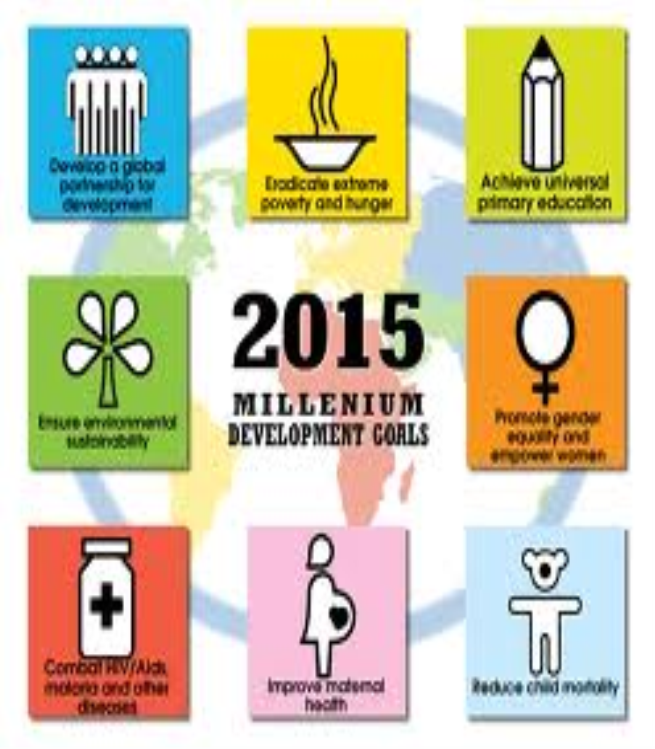Millennium Development Goals (MDGs)
| ✅ Paper Type: Free Essay | ✅ Subject: Media |
| ✅ Wordcount: 1111 words | ✅ Published: 12 Oct 2017 |
The Millennium Development Goals (MDG’s)
This lesson deals with the Millennium Development Goals (MDGs). MDGs are derived from earlier development targets. The MDG’s originated from the United Nations Millennium Declaration, was the main outcome of the Millennium Summit. The Declaration asserted that every individual has dignity; therefore, the right to freedom, equality, a basic standard of living. MDG’s emphasized the role of developed countries in aiding developing countries, as outlined in Goal Eight, which sets objectives and targets for developed countries to achieve a “global partnership for development”
________________________________________________________________________________
- Objectives
After going through this lesson, you should be able to:
- describe the millennium development goals-(MDGs)
- Focus on three major areas for improvement.
________________________________________________________________________________________
7.1 Introduction
It is not the United Nations that has to achieve millennium development goals; they have to be achieved by every country, by the joint efforts of government and people. The millennium declaration promises people from the dehumanising conditions of extreme poverty, make the right to development a success and reality for everyone. Each goal is easy to understand and implement. The Millennium Development Goals (MDG’s) are the world’s biggest promise – a global agreement through collaborative action.
Any happening in one country undoubtedly affects those who live in other countries. We need to have a safe and secure world unless we react all against poverty, injustice and inequality. We can eradicate poverty, since we have the resources, and know how. Let us make best of opportunity. One World One Hope: to achieve our global commitments and vision of the Millennium Development Goals targets by 2015.
________________________________________________________________________________________
7.3 THE MILLENNIUM DEVELOPMENT GOALS-(MDG’s)
The Millennium Development Goals (MDG’s) are the most broadly supported, comprehensive and specific development goals the world has ever agreed upon. These eight time-bound goals provide concrete, numerical benchmarks for tackling extreme poverty in its many dimensions. They include goals and targets on income, poverty, hunger, maternal and child mortality, disease, inadequate shelter, gender inequality, environmental degradation and the Global Partnership for Development.

Goal 1: Eradicate extreme poverty and hunger
Targets
Target 1a: Reduce by half the proportion of people living on less than a dollar a day
|
Target 1b: Achieve full and productive employment and decent work for all, including women and young people
|
Target 1c: Reduce by half the proportion of people who suffer from hunger
|
Goal 2: Achieve universal primary education
Targets
Target 2a: Ensure that all boys and girls complete a full course of primary schooling
|
Goal 3: Promote gender equality and empower women
Target 3a: Eliminate gender disparity in primary and secondary education preferably by 2005, and at all levels by 2015
|
Goal 4: Reduce child mortality
Targets
Target 4a: Reduce by two thirds the mortality rate among children under five
|
Goal 5: Improve maternal health
Indicators
Target 5a: Reduce by three quarters the maternal mortality ratio
|
Target 5b: Achieve, by 2015, universal access to reproductive health
|
Goal 6: Combat HIV/AIDS, malaria and other diseases
Targets
Target 6a: Halt and begin to reverse the spread of HIV/AIDS
|
Target 6b: Achieve, by 2010, universal access to treatment for HIV/AIDS for all those who need it
Goal 7: Ensure environmental sustainability |
Targets
Target 7a: Integrate the principles of sustainable development into country policies and programmes; reverse loss of environmental resources.
Target 7b: Reduce biodiversity loss, achieving, by 2010, a significant reduction in the rate of loss.
Target 7a and 7b Indicators:
|
Target 7c: Reduce by half the proportion of people without sustainable access to safe drinking water and basic sanitation
Goal 8: A global partnership for developments
Target 8a: Develop further an open, rule-based, predictable, non-discriminatory trading and financial system Includes a commitment to good governance, development and poverty reduction; both nationally and internationally.
Target 8b: Address the special needs of the least developed countries Includes tariff and quota free access for the least developed countries’ exports; enhanced programme of debt relief for heavily indebted poor countries (HIPC) and cancellation of official bilateral debt; and more generous ODA for countries committed to poverty reduction.
Target 8c: Address the special needs of landlocked developing countries and Small Island developing States through the Programme of Action for the Sustainable Development of Small Island Developing States and the outcome of the twenty-second special session of the General Assembly.
Target 8d: Deal comprehensively with the debt problems of developing countries through national and international measures in order to make debt sustainable in the long term.
_______________________________________________________________________________________
Summing Up:
The Millennium Development Goals (MDGs), endorsed by governments at the United Nations in September 2000, aimed to improve human well-being by reducing poverty, hunger, child and maternal mortality, ensuring education for all, controlling and managing diseases, tackling gender disparity, ensuring sustainable development and pursuing global partnerships. This would help to bring underdeveloped and developing nations on the next level of progress.
Cite This Work
To export a reference to this article please select a referencing stye below:
Related Services
View allDMCA / Removal Request
If you are the original writer of this essay and no longer wish to have your work published on UKEssays.com then please click the following link to email our support team:
Request essay removal


